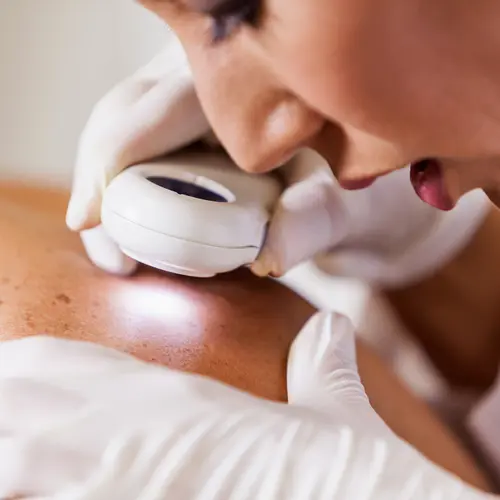Acral lentiginous melanoma is sometimes called acral melanoma. It is a subtype of melanoma that appears on the:
- Palms of your hands
- Soles of your feet
- Underneath your fingernails
- Underneath your toenails
Acral lentiginous melanoma is a very rare type of skin cancer, and it affects people with darker skin more than any other demographic. Other types of melanoma are caused by sun exposure that damages your skin. However, scientists and medical professionals do not see correlations between sun exposure and the development of acral lentiginous melanoma spots.
Understanding Acral Lentiginous Melanoma
The name "acral lentiginous melanoma" is long, but it is specific to the location and coloring of this particular melanoma. The word acral translates to "extremity" in Greek, and this type of skin cancer affects the extremities of your limbs. The word lentiginous refers to the color of the spots because they tend to be darker than the normal pigment of your skin.
The development of acral lentiginous melanoma begins as a small, superficial spot on the surface of your skin. You may not notice or think much of it at first because its appearance isn't alarming. This type of melanoma is uncommon in comparison to other types of skin cancer that are diagnosed, but it is the most common skin cancer for people who have darker skin. This includes African Americans and people of Asian descent.
Spots of acral lentiginous melanoma start because the melanocyte cells in your skin begin to grow faster than normal, forming tumors. Because these melanocyte cells are responsible for the color of your skin, their rapid production leads to spots that are a different color than your usual skin tone.
There are misconceptions that skin cancer is only caused by sun exposure and that only fair-skinned people can get skin cancer. Because of this, acral lentiginous melanoma goes largely ignored. It may not be diagnosed until the later stages of the condition. However, by then, it may grow deeper into your skin or metastasize to affect more of your body.
Identifying acral lentiginous melanoma. This skin cancer begins as a dark spot on your skin. It may have a clear border separating it from the surrounding skin of a lighter color. Because it primarily affects people with darker skin, it isn’t always obvious at first.
In rare cases, acral lentiginous melanoma appears red or orange. These are called amelanotic or non-pigmented melanoma. Signs of acral lentiginous melanoma include:
- A strip of color appearing under your finger or toenail that isn’t caused by an accident or bruise. It often looks like a line running down the length of the skin under your fingernail
- Damage to your nail that doesn't have an apparent cause
- A previous spot that begins to change in color or appearance
- A spot that grows larger
- A spot that connects to an existing mole on your hands or feet
- A spot that raises up off your skin and feels thick
Having melanoma appear in your nail bed is not common but represents one-third of melanoma diagnoses in darker-skinned people. Thumbs and big toes are the most common nail sites. You may think that the melanoma is a fungal infection. If you seek treatment for another condition and there is no change, talk to your doctor.
Acral Lentiginous Melanoma Risks
Because acral lentiginous melanoma isn’t a result of increased sun exposure, genetics may be a contributing factor to its development. If you know of a family member who was diagnosed with acral lentiginous melanoma, you may be at a greater risk for the condition as well.
Acral lentiginous melanoma death rates are higher than with other types of melanoma because it often goes unnoticed for so long. This is why it is important to talk to your doctor any time you notice changes in your skin that aren’t temporary.
It’s also important to note that men are more likely than women to have large growths at the point of diagnosis.
Treating Acral Lentiginous Melanoma
Acral lentiginous melanoma is a treatable skin cancer when your doctor catches it early. The goal of treating acral lentiginous melanoma is to carefully remove the cancer cells from your body while preserving as much of the surrounding skin as possible. Your doctor will also want to ensure that the cancer doesn't return. Your long-term care plan may include more frequent skin checks to ensure no new spots appear.
Additionally, your doctor will create an individualized care plan that is based on the severity of your skin cancer. You are most likely to undergo surgery that completely removes the spot. Your doctor may send the growth to a lab for a biopsy to assess the stage of your cancer and ensure that all cancerous cells are gone.
If your skin cancer goes untreated for too long and metastasizes, it spreads to other parts of your body. At that point, your doctor may also suggest treatments like radiation, chemotherapy, immunotherapy, targeted therapy, or a combination of therapies to kill additional cancer cells.

